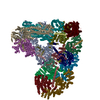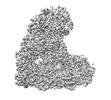登録情報 データベース : EMDB / ID : EMD-19711タイトル Cryo-EM structure of the Anaphase-promoting complex/cyclosome (APC/C) bound to co-activator Cdh1 at 3.2 Angstrom resolution Overall map (sharpened with deepEMhancer) of the Anaphase-promoting complex/cyclosome (APC/C) bound to co-factor Cdh1 at 3.2 A resolution. 複合体 : Anaphase-promoting complex (APC/C) bound to co-activator Cdh1リガンド : x 1種 / / / / / / / 機能・相同性 分子機能 ドメイン・相同性 構成要素
/ / / / / / / / / / / / / / / / / / / / / / / / / / / / / / / / / / / / / / / / / / / / / / / / / / / / / / / / / / / / / / / / / / / / / / / / / / / / / / / / / / / / / / / / / / / / / / / / / / / / / / / / / / / / / / / / / / / / / / / / / / / / / / / / / / / / / / / / / / / / / / / / / / / / / / / / / / / / / / / / / / / / / / / / / / / / / / / / / / / / / / / / / / / / / / / / / / / / / / / / / / / / / / / / / / / / / / / / / / / / / / / / / 生物種 Homo sapiens (ヒト)手法 / / 解像度 : 3.2 Å Hoefler A / Yu J / Chang L / Zhang Z / Yang J / Boland A / Barford D 資金援助 Organization Grant number 国 Swiss National Science Foundation 310030_185235 Medical Research Council (MRC, United Kingdom) MC_UP_1201/6
ジャーナル : Nat Commun / 年 : 2024タイトル : Cryo-EM structures of apo-APC/C and APC/C complexes provide insights into APC/C regulation.著者 : Anna Höfler / Jun Yu / Jing Yang / Ziguo Zhang / Leifu Chang / Stephen H McLaughlin / Geoffrey W Grime / Elspeth F Garman / Andreas Boland / David Barford / 要旨 : APC/C is a multi-subunit complex that functions as a master regulator of cell division. It controls progression through the cell cycle by timely marking mitotic cyclins and other cell cycle ... APC/C is a multi-subunit complex that functions as a master regulator of cell division. It controls progression through the cell cycle by timely marking mitotic cyclins and other cell cycle regulatory proteins for degradation. The APC/C itself is regulated by the sequential action of its coactivator subunits CDC20 and CDH1, post-translational modifications, and its inhibitory binding partners EMI1 and the mitotic checkpoint complex. In this study, we took advantage of developments in cryo-electron microscopy to determine the structures of human APC/C and apo-APC/C at 2.9 Å and 3.2 Å resolution, respectively, providing insights into the regulation of APC/C activity. The high-resolution maps allow the unambiguous assignment of an α-helix to the N-terminus of CDH1 (CDH1) in the APC/C ternary complex. We also identify a zinc-binding module in APC2 that confers structural stability to the complex, and we confirm the presence of zinc ions experimentally. Finally, due to the higher resolution and well defined density of these maps, we are able to build, aided by AlphaFold predictions, several intrinsically disordered regions in different APC/C subunits that likely play a role in proper APC/C assembly and regulation of its activity. 履歴 登録 2024年2月21日 - ヘッダ(付随情報) 公開 2024年3月13日 - マップ公開 2024年3月13日 - 更新 2025年2月5日 - 現状 2025年2月5日 処理サイト : PDBe / 状態 : 公開
すべて表示 表示を減らす
 データを開く
データを開く 基本情報
基本情報
 マップデータ
マップデータ 試料
試料 キーワード
キーワード 機能・相同性情報
機能・相同性情報 Homo sapiens (ヒト)
Homo sapiens (ヒト) データ登録者
データ登録者 スイス,
スイス,  英国, 2件
英国, 2件  引用
引用 ジャーナル: Nat Commun / 年: 2024
ジャーナル: Nat Commun / 年: 2024

 構造の表示
構造の表示 ダウンロードとリンク
ダウンロードとリンク emd_19711.map.gz
emd_19711.map.gz EMDBマップデータ形式
EMDBマップデータ形式 emd-19711-v30.xml
emd-19711-v30.xml emd-19711.xml
emd-19711.xml EMDBヘッダ
EMDBヘッダ emd_19711.png
emd_19711.png emd-19711.cif.gz
emd-19711.cif.gz emd_19711_additional_1.map.gz
emd_19711_additional_1.map.gz emd_19711_additional_2.map.gz
emd_19711_additional_2.map.gz emd_19711_half_map_1.map.gz
emd_19711_half_map_1.map.gz emd_19711_half_map_2.map.gz
emd_19711_half_map_2.map.gz http://ftp.pdbj.org/pub/emdb/structures/EMD-19711
http://ftp.pdbj.org/pub/emdb/structures/EMD-19711 ftp://ftp.pdbj.org/pub/emdb/structures/EMD-19711
ftp://ftp.pdbj.org/pub/emdb/structures/EMD-19711 emd_19711_validation.pdf.gz
emd_19711_validation.pdf.gz EMDB検証レポート
EMDB検証レポート emd_19711_full_validation.pdf.gz
emd_19711_full_validation.pdf.gz emd_19711_validation.xml.gz
emd_19711_validation.xml.gz emd_19711_validation.cif.gz
emd_19711_validation.cif.gz https://ftp.pdbj.org/pub/emdb/validation_reports/EMD-19711
https://ftp.pdbj.org/pub/emdb/validation_reports/EMD-19711 ftp://ftp.pdbj.org/pub/emdb/validation_reports/EMD-19711
ftp://ftp.pdbj.org/pub/emdb/validation_reports/EMD-19711


 F&H 検索
F&H 検索 リンク
リンク EMDB (EBI/PDBe) /
EMDB (EBI/PDBe) /  EMDataResource
EMDataResource マップ
マップ ダウンロード / ファイル: emd_19711.map.gz / 形式: CCP4 / 大きさ: 178 MB / タイプ: IMAGE STORED AS FLOATING POINT NUMBER (4 BYTES)
ダウンロード / ファイル: emd_19711.map.gz / 形式: CCP4 / 大きさ: 178 MB / タイプ: IMAGE STORED AS FLOATING POINT NUMBER (4 BYTES) 試料の構成要素
試料の構成要素 解析
解析 試料調製
試料調製 電子顕微鏡法
電子顕微鏡法 FIELD EMISSION GUN
FIELD EMISSION GUN
 ムービー
ムービー コントローラー
コントローラー






























 Z (Sec.)
Z (Sec.) Y (Row.)
Y (Row.) X (Col.)
X (Col.)




















































 Trichoplusia ni (イラクサキンウワバ)
Trichoplusia ni (イラクサキンウワバ)

